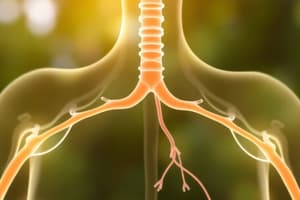Podcast
Questions and Answers
Which process occurs in the absence of oxygen?
Which process occurs in the absence of oxygen?
- Aerobic cellular respiration
- Anaerobic cellular respiration (correct)
- Oxidative phosphorylation
- Photosynthesis
What is the net gain of ATP molecules per glucose molecule in aerobic cellular respiration?
What is the net gain of ATP molecules per glucose molecule in aerobic cellular respiration?
- 4 ATP molecules
- 2 ATP molecules
- 36-38 ATP molecules (correct)
- 10 ATP molecules
Where does photosynthesis occur in plant cells?
Where does photosynthesis occur in plant cells?
- Mitochondria
- Cytoplasm
- Chloroplasts (correct)
- Nucleus
What is the byproduct of photosynthesis?
What is the byproduct of photosynthesis?
What is the type of anaerobic cellular respiration that occurs in muscle cells during high-intensity, short-duration activities?
What is the type of anaerobic cellular respiration that occurs in muscle cells during high-intensity, short-duration activities?
What is the energy yield of anaerobic cellular respiration compared to aerobic respiration?
What is the energy yield of anaerobic cellular respiration compared to aerobic respiration?
Which stage of aerobic cellular respiration involves the breakdown of glucose into carbon dioxide and water?
Which stage of aerobic cellular respiration involves the breakdown of glucose into carbon dioxide and water?
What is the purpose of chlorophyll in photosynthesis?
What is the purpose of chlorophyll in photosynthesis?
What is the industrial application of fermentation?
What is the industrial application of fermentation?
Which process is responsible for the conversion of light energy into chemical energy?
Which process is responsible for the conversion of light energy into chemical energy?
Flashcards are hidden until you start studying
Study Notes
Cellular Respiration
Anaerobic Cellular Respiration
- Also known as fermentation
- Occurs in the absence of oxygen (O2)
- Glucose (C6H12O6) is broken down into lactic acid (C3H6O3) or ethanol (C2H5OH) and carbon dioxide (CO2)
- Net gain of 2 ATP molecules per glucose molecule
- Energy yield is low compared to aerobic respiration
- Occurs in muscle cells during high-intensity, short-duration activities
- Also occurs in some microorganisms, such as yeast, and in muscle cells during oxygen deprivation
Aerobic Cellular Respiration
- Occurs in the presence of oxygen (O2)
- Glucose (C6H12O6) is broken down into carbon dioxide (CO2) and water (H2O)
- Net gain of 36-38 ATP molecules per glucose molecule
- Energy yield is high compared to anaerobic respiration
- Occurs in mitochondria of cells in the presence of oxygen
- Involves three stages: glycolysis, citric acid cycle, and oxidative phosphorylation
Photosynthesis
- Process by which plants, algae, and some bacteria convert light energy into chemical energy
- Light energy from the sun is absorbed by pigments such as chlorophyll
- Water (H2O) and carbon dioxide (CO2) are converted into glucose (C6H12O6) and oxygen (O2)
- Glucose is used as energy and building blocks for growth and development
- Oxygen is released as a byproduct
- Occurs in chloroplasts of plant cells
Fermentation
- A type of anaerobic cellular respiration
- Glucose (C6H12O6) is broken down into lactic acid (C3H6O3) or ethanol (C2H5OH) and carbon dioxide (CO2)
- Net gain of 2 ATP molecules per glucose molecule
- Energy yield is low compared to aerobic respiration
- Occurs in muscle cells during high-intensity, short-duration activities
- Also occurs in some microorganisms, such as yeast, and in muscle cells during oxygen deprivation
- Has industrial applications, such as in the production of bread, beer, and biofuels
Cellular Respiration
Anaerobic Cellular Respiration
- Fermentation occurs in the absence of oxygen (O2)
- Glucose (C6H12O6) breaks down into lactic acid (C3H6O3) or ethanol (C2H5OH) and carbon dioxide (CO2)
- Produces 2 ATP molecules per glucose molecule
- Energy yield is low compared to aerobic respiration
- Occurs in muscle cells during high-intensity, short-duration activities and in some microorganisms
Aerobic Cellular Respiration
- Occurs in the presence of oxygen (O2)
- Glucose (C6H12O6) breaks down into carbon dioxide (CO2) and water (H2O)
- Produces 36-38 ATP molecules per glucose molecule
- Energy yield is high compared to anaerobic respiration
- Occurs in mitochondria of cells in the presence of oxygen
- Involves three stages: glycolysis, citric acid cycle, and oxidative phosphorylation
Photosynthesis
- Converts light energy into chemical energy
- Occurs in plants, algae, and some bacteria
- Light energy is absorbed by pigments such as chlorophyll
- Water (H2O) and carbon dioxide (CO2) convert into glucose (C6H12O6) and oxygen (O2)
- Glucose is used for energy and growth
- Oxygen is released as a byproduct
- Occurs in chloroplasts of plant cells
Fermentation
- A type of anaerobic cellular respiration
- Produces 2 ATP molecules per glucose molecule
- Occurs in muscle cells during high-intensity, short-duration activities
- Occurs in some microorganisms, such as yeast
- Has industrial applications in bread, beer, and biofuels production
Studying That Suits You
Use AI to generate personalized quizzes and flashcards to suit your learning preferences.





